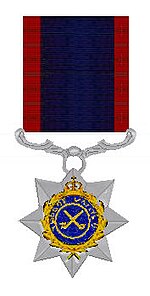| Indian Order of Merit | |
|---|---|
 Indian Order of Merit (2nd Class, Military Division) (top) Ribbon (bottom) | |
| Awarded by British Empire | |
| Type | Military decoration |
| Eligibility | Indian citizens in the armed forces and civilians (civilian division) |
| Awarded for | Gallantry |
| Status | Discontinued in 1947 |
| Clasps | No clasps |
| Post-nominals | IOM |
| Statistics | |
| Established | 1837 |
| Precedence | |
| Next (higher) | Victoria Cross |

Indian Order of Merit, First Second and Third Classes
The Indian Order of Merit (IOM) was a military and civilian decoration of British India. It was established in 1837, although following the Partition of India in 1947 it was decided to discontinue the award and in 1954 a separate Indian honours system was developed, to act retrospectively to 1947. For a long period of time the IOM was the highest decoration that a native member of the British Indian Army could receive and initially it had three divisions. This was changed in 1911 when Indian servicemen became eligible for the Victoria Cross. A civilian division of the IOM also existed between 1902 and 1939, however, it was only conferred very rarely.
History[]
The medal was first introduced by the East India Company in 1837, and was taken over by the Crown in 1858, following the Indian Mutiny of 1857. The Indian Order of Merit was the only gallantry medal available to Native soldiers between 1837 and 1907 when the Indian Distinguished Service Medal was introduced, and when the Victoria Cross was opened to native soldiers in 1911. Both divisions of the order were removed when India became independent in 1947. Recipients receive the post nominal letters IOM.
The medal[]
Military Division[]
The medal was originally introduced with three classes (first, second and third classes), until others medals were made available to Indian soldiers, at which point it was reduced to two classes (the Victoria Cross replacing the first class), and reduced to one class in 1944. A recipient technically needed to be in possession of the lower class before being awarded a higher class, although recipients were sometimes awarded the higher class if they performed more than one act of gallantry, then they may have been awarded the higher class, without receiving the lower one. The recipients of the order received increased pay and pension allowances and were very highly regarded.
Civil Division[]
A civil division was available in two classes between 1902 and 1939, when it was reduced to one class. The civil medal was rarely awarded.
Description[]
Third Class[]
Eight pointed dull silver star with blue circle, surrounded by silver laurels, in the middle, with crossed swords and the words Awarded for Valour, this was changed to Awarded for Gallantry in 1944.
Second Class[]
Eight pointed shiny silver star with blue circle, surrounded by gold laurels in the middle, with crossed swords and the words Awarded for Valour, this was changed to Awarded for Gallantry in 1944.
First Class[]
Eight pointed gold star with blue circle, surrounded by gold laurels in the middle, with crossed swords and the words Awarded for Valour, this was changed to Awarded for Gallantry in 1944. Lieutenant Sardar Bahadur Ahmadullah Khan, Khan Bahadur, IOM, OBI (1st Class 1 January 1909), IMD Khillat Sword of Honour, Jagirdar and Honorary Magistrate.2nd Class Order of Merit for consipicous gallantry. In action at Ghazikot on the Black Mountain (Hazara) on the 19th March 1891, on which occasional not with standing his being exposed to heavy fire he performed his duties of attending to the wounded in a most energetic manner & also defended a wounded man against a fanatic who rushed up and endeavoured to kill him. (4) Good and Meritorious Service rendered with Waziristan delimitation escort were recognized by the P.M.O.in India in his Letter No.3106 Dated 03-10-1895.
Ribbon[]
Dark Blue ribbon flanked by two red stripes of about a sixth of the width.
Recipients
- Subedar Major & Honorary Lieutenant Ram Singh Kaila, Bahadur, IOM, OBI, of 15 LOODIANAH SIKHS ( 1887-1916), 82 PUNJABIS (1916-21). IOM for gallant at Chagra Kotal ( Tirah, NWFP) vide GGO No. 430 of 1898. OBI vide Gazette of India No. 872 of 1917.
- Risaldar Bharat Singh, IOM (I.O. 12385) of 7th Light Cavalry (37 Ind Inf Bde/23 Ind Div/IV Corps/XIV Army) for gallant in Burma vide Gazette of India No. 100H dated 4 May 1944.
References[]
Duckers, Peter (2009) [2004]. British Orders and Decorations. Oxford: Shire Publications. ISBN 978-0-7478-0580-9. OCLC 55587484.
Further reading[]
C Parrett & Rana Chhina (2010). "Indian Order of Merit: Historical Records, 1837-1860" Vol I. Tom Donovan Editions, Brighton, UK.. Further volumes of this comprehensive work are in the process of compilation and will bring the records up to 1947, ultimately.
External links[]
- Search recommendations for the Indian Order of Merit on The UK National Archives' website.
- The Website of the Indian Military Historical Society
| ||||||||||||||
The original article can be found at Indian Order of Merit and the edit history here.